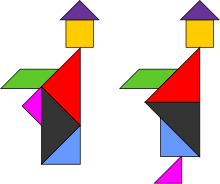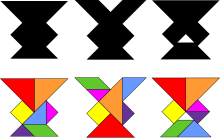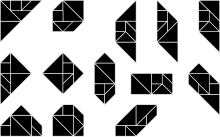Tangram

The tangram (Chinese: 七巧板; pinyin: qīqiǎobǎn; lit. 'seven boards of skill') is a dissection puzzle consisting of seven flat polygons, called tans, which are put together to form shapes. The objective is to replicate a pattern (given only an outline) generally found in a puzzle book using all seven pieces without overlap. Alternatively the tans can be used to create original minimalist designs that are either appreciated for their inherent aesthetic merits or as the basis for challenging others to replicate its outline. It is reputed to have been invented in China sometime around the late 18th century CE and then carried over to America and Europe by trading ships shortly after.[1] It became very popular in Europe for a time, and then again during World War I. It is one of the most widely recognized dissection puzzles in the world and has been used for various purposes including amusement, art, and education.[2][3]
Etymology
The origin of the word 'tangram' is unclear. One conjecture holds that it is a compound of the Greek element '-gram' derived from γράμμα ('written character, letter, that which is drawn') with the 'tan-' element being variously conjectured to be Chinese t'an 'to extend' or Cantonese t'ang 'Chinese'.[4] Alternatively, the word may be derivative of the archaic English 'trangram' meaning "an odd, intricately contrived thing".[5]
In either case, the first known use of the word is believed to be found in the 1848 book Geometrical Puzzle for the Young by mathematician and future Harvard University president Thomas Hill who likely coined the term in the same work. Hill vigorously promoted the word in numerous articles advocating for the puzzle's use in education and in 1864 it received official recognition in the English language when it was included in Noah Webster's American Dictionary.[6]
History
Origins
The early years of attempting to date the Tangram were confused by the popular but fraudulently written history by famed puzzle maker Samuel Loyd in his 1908 The Eighth Book Of Tan. This work contains many whimsical features that aroused both interest and suspicion amongst contemporary scholars who attempted to verify the account. By 1910 it was clear that it was a hoax. A letter dated from this year from the Oxford Dictionary editor Sir James Murray on behalf of a number of Chinese scholars to the prominent puzzlist Henry Dudeney reads "The result has been to show that the man Tan, the god Tan, and the Book of Tan are entirely unknown to Chinese literature, history or tradition." [7] Along with its many strange details The Eighth Book of Tan's date of creation for the puzzle of 4000 years in antiquity had to be regarded as entirely baseless and false.
The Tangram's historical Chinese inventor is unknown except through the pen name Yang-cho-chu-shih (Dim-witted recluse). It is believed that the puzzle was originally introduced in a book titled Ch'i chi'iao t'u which was already being reported as lost in 1815 by Shan-chiao in his book New Figures of the Tangram. Nevertheless, it is generally reputed that the puzzle's origins would have been around 20 years earlier than this. [8]
Despite its relatively recent creation, there is a much older tradition of dissection amusements in China which likely played a role in its inspiration. In particular, the modular banquet tables of the Song dynasty bear an uncanny resemblance to the playing pieces of the Tangram and there were books dedicated to arranging them together to form pleasing patterns.[9]
The prominent third-century mathematician Liu Hui made use of construction proofs in his works and some bear a striking resemblance to the subsequently developed Banquet tables which in turn seem to anticipate the Tangram. While there is no reason to suspect that tangrams were used in the proof of the Pythagorean theorem, as is sometimes reported, it is likely that this style of geometric reasoning went on to exert an influence on Chinese cultural life that lead directly to the puzzle.[10]
Reaching the Western world (1815–1820s)

The earliest extant tangram was given to the Philadelphia shipping magnate and congressman Francis Waln in 1802 but it was not until over a decade later that Western audiences, at large, would be exposed to the puzzle. [11] In 1815, American Captain M. Donnaldson was given a pair of author Sang-Hsia-koi's books on the subject (one problem and one solution book) when his ship, Trader docked there. They were then brought with the ship to Philadelphia,in February 1816. The first tangram book to be published in America was based on the pair brought by Donnaldson.[12]
The puzzle eventually reached England, where it became very fashionable. The craze quickly spread to other European countries. This was mostly due to a pair of British tangram books, The Fashionable Chinese Puzzle, and the accompanying solution book, Key.[13] Soon, tangram sets were being exported in great number from China, made of various materials, from glass, to wood, to tortoise shell.[14]
Many of these unusual and exquisite tangram sets made their way to Denmark. Danish interest in tangrams skyrocketed around 1818, when two books on the puzzle were published, to much enthusiasm.[15] The first of these was Mandarinen (About the Chinese Game). This was written by a student at Copenhagen University, which was a non-fictional work about the history and popularity of tangrams. The second, Det nye chinesiske Gaadespil (The new Chinese Puzzle Game), consisted of 339 puzzles copied from The Eighth Book of Tan, as well as one original.[15]
One contributing factor in the popularity of the game in Europe was that although the Catholic Church forbade many forms of recreation on the sabbath, they made no objection to puzzle games such as the tangram.[16]
Second craze in Germany (1891–1920s)
Tangrams were first introduced to the German public by industrialist Friedrich Adolf Richter around 1891.[17] The sets were made out of stone or false earthenware,[18] and marketed under the name "The Anchor Puzzle".[17]
More internationally, the First World War saw a great resurgence of interest in tangrams, on the homefront and trenches of both sides. During this time, it occasionally went under the name of "The Sphinx" an alternative title for the "Anchor Puzzle" sets.[19][20]
Paradoxes

In figure 1, side lengths are labelled assuming the square has unit sides.
In figure 2, overlaying the bodies shows that footless body is larger by the foot's area. The change in area is often unnoticed as √2 is close to 1.5.
A tangram paradox is a dissection fallacy: Two figures composed with the same set of pieces, one of which seems to be a proper subset of the other.[21] One famous paradox is that of the two monks, attributed to Dudeney, which consists of two similar shapes, one with and the other missing a foot.[22] In reality, the area of the foot is compensated for in the second figure by a subtly larger body. Another tangram paradox is proposed by Sam Loyd in The 8th Book of Tan:[23]
The seventh and eighth figures represent the mysterious square, built with seven pieces: then with a corner clipped off, and still the same seven pieces employed.[24]
The two-monks paradox – two similar shapes but one missing a foot:

The Magic Dice Cup tangram paradox – from Sam Loyd's book The Eighth Book of Tan[25] (1903). Each of these cups was composed using the same seven geometric shapes. But the first cup is whole, and the others contain vacancies of different sizes. (Notice that the one on the left is slightly shorter than the other two. The one in the middle is ever-so-slightly wider than the one on the right, and the one on the left is narrower still.)[26]

Clipped square tangram paradox – from Loyd's book The Eighth Book of Tan[25] (1903):
Number of configurations

Over 6500 different tangram problems have been created from 19th century texts alone, and the current number is ever-growing.[27] Fu Traing Wang and Chuan-Chin Hsiung proved in 1942 that there are only thirteen convex tangram configurations (config segment drawn between any two points on the configuration's edge always pass through the configuration's interior, i.e., configurations with no recesses in the outline).[28][29]
Pieces
Choosing a unit of measurement so that the seven pieces can be assembled to form a square of side one unit and having area one square unit, the seven pieces are:[30]
- 2 large right triangles (hypotenuse 1, sides √2/2, area 1/4)
- 1 medium right triangle (hypotenuse √2/2, sides 1/2, area 1/8)
- 2 small right triangles (hypotenuse 1/2, sides √2/4, area 1/16)
- 1 square (sides √2/4, area 1/8)
- 1 parallelogram (sides of 1/2 and √2/4, height of 1/4, area 1/8)
Of these seven pieces, the parallelogram is unique in that it has no reflection symmetry but only rotational symmetry, and so its mirror image can be obtained only by flipping it over. Thus, it is the only piece that may need to be flipped when forming certain shapes.
See also
References
- ^ Slocum, Jerry (2003). The Tangram Book. Sterling. p. 21. ISBN 9781402704130.
- ^ Slocum, Jerry (2001). The Tao of Tangram. Barnes & Noble. p. 9. ISBN 978-1-4351-0156-2.
{{cite book}}: Invalid|ref=harv(help) - ^ Forbrush, William Byron (1914). Manual of Play. Jacobs. p. 315. Retrieved 2010-10-13.
- ^ Oxford English Dictionary, 1910, s.v.
- ^ Slocum, Jerry (2003). The Tangram Book. Sterling. p. 23. ISBN 9781402704130.
- ^ Slocum, Jerry (2003). The Tangram Book. Sterling. p. 25. ISBN 9781402704130.
- ^ Slocum, Jerry (2003). The Tangram Book. Sterling. p. 23. ISBN 9781402704130.
- ^ Slocum, Jerry (2003). The Tangram Book. Sterling. p. 16-19. ISBN 9781402704130.
- ^ Slocum, Jerry (2003). The Tangram Book. Sterling. p. 16. ISBN 9781402704130.
- ^ Slocum, Jerry (2003). The Tangram Book. Sterling. p. 15. ISBN 9781402704130.
- ^ Slocum, Jerry (2003). The Tangram Book. Sterling. p. 21. ISBN 9781402704130.
- ^ Slocum, Jerry (2003). The Tangram Book. Sterling. p. 30. ISBN 9781402704130.
- ^ Slocum (2003, p. 31) harvtxt error: multiple targets (9×): CITEREFSlocum2003 (help)
- ^ Slocum (2003, p. 49) harvtxt error: multiple targets (9×): CITEREFSlocum2003 (help)
- ^ a b Slocum (2003, pp. 99–100) harvtxt error: multiple targets (9×): CITEREFSlocum2003 (help)
- ^ Slocum (2003, p. 51) harvtxt error: multiple targets (9×): CITEREFSlocum2003 (help)
- ^ a b waeber, sarcone &. "Tangram the incredible timeless 'Chinese' puzzle 2". www.archimedes-lab.org.
- ^ Treasury Decisions Under customs and other laws, Volume 25. United States Department Of The Treasury. 1890–1926. p. 1421. Retrieved September 16, 2010.
- ^ Wyatt (26 April 2006). "Tangram – The Chinese Puzzle". BBC. Retrieved 3 October 2010.
- ^ Braman, Arlette (2002). Kids Around The World Play!. John Wiley and Sons. p. 10. ISBN 978-0-471-40984-7. Retrieved September 5, 2010.
- ^ Tangram Paradox, by Barile, Margherita, From MathWorld – A Wolfram Web Resource, created by Eric W. Weisstein.
- ^ Dudeney, H. (1958). Amusements in Mathematics. New York: Dover Publications.
- ^ The 8th Book of Tan (1903).
- ^ Loyd, Sam (1968). The eighth book of Tan – 700 Tangrams by Sam Loyd with an introduction and solutions by Peter Van Note. New York: Dover Publications. p. 25.
- ^ a b The Eighth Book of Tan, page 1
- ^ "The Magic Dice Cup". 2 April 2011.
- ^ Slocum (2001, p. 37)
- ^ Fu Traing Wang; Chuan-Chih Hsiung (November 1942). "A Theorem on the Tangram". The American Mathematical Monthly. 49 (9): 596–599. doi:10.2307/2303340. JSTOR 2303340.
- ^ Read, Ronald C. (1965). Tangrams : 330 Puzzles. New York: Dover Publications. p. 53. ISBN 0-486-21483-4.
- ^ Brooks, David J. (2018-12-01). "How to Make a Classic Tangram Puzzle". Boys' Life magazine. Retrieved 2020-03-10.
Further reading
- Anno, Mitsumasa. Anno's Math Games (three volumes). New York: Philomel Books, 1987. ISBN 0-399-21151-9 (v. 1), ISBN 0-698-11672-0 (v. 2), ISBN 0-399-22274-X (v. 3).
- Botermans, Jack, et al. The World of Games: Their Origins and History, How to Play Them, and How to Make Them (translation of Wereld vol spelletjes). New York: Facts on File, 1989. ISBN 0-8160-2184-8.
- Dudeney, H. E. Amusements in Mathematics. New York: Dover Publications, 1958.
- Gardner, Martin. "Mathematical Games—on the Fanciful History and the Creative Challenges of the Puzzle Game of Tangrams", Scientific American Aug. 1974, p. 98–103.
- Gardner, Martin. "More on Tangrams", Scientific American Sep. 1974, p. 187–191.
- Gardner, Martin. The 2nd Scientific American Book of Mathematical Puzzles and Diversions. New York: Simon & Schuster, 1961. ISBN 0-671-24559-7.
- Loyd, Sam. Sam Loyd's Book of Tangram Puzzles (The 8th Book of Tan Part I). Mineola, New York: Dover Publications, 1968.
- Slocum, Jerry, et al. Puzzles of Old and New: How to Make and Solve Them. De Meern, Netherlands: Plenary Publications International (Europe); Amsterdam, Netherlands: ADM International; Seattle: Distributed by University of Washington Press, 1986. ISBN 0-295-96350-6.
